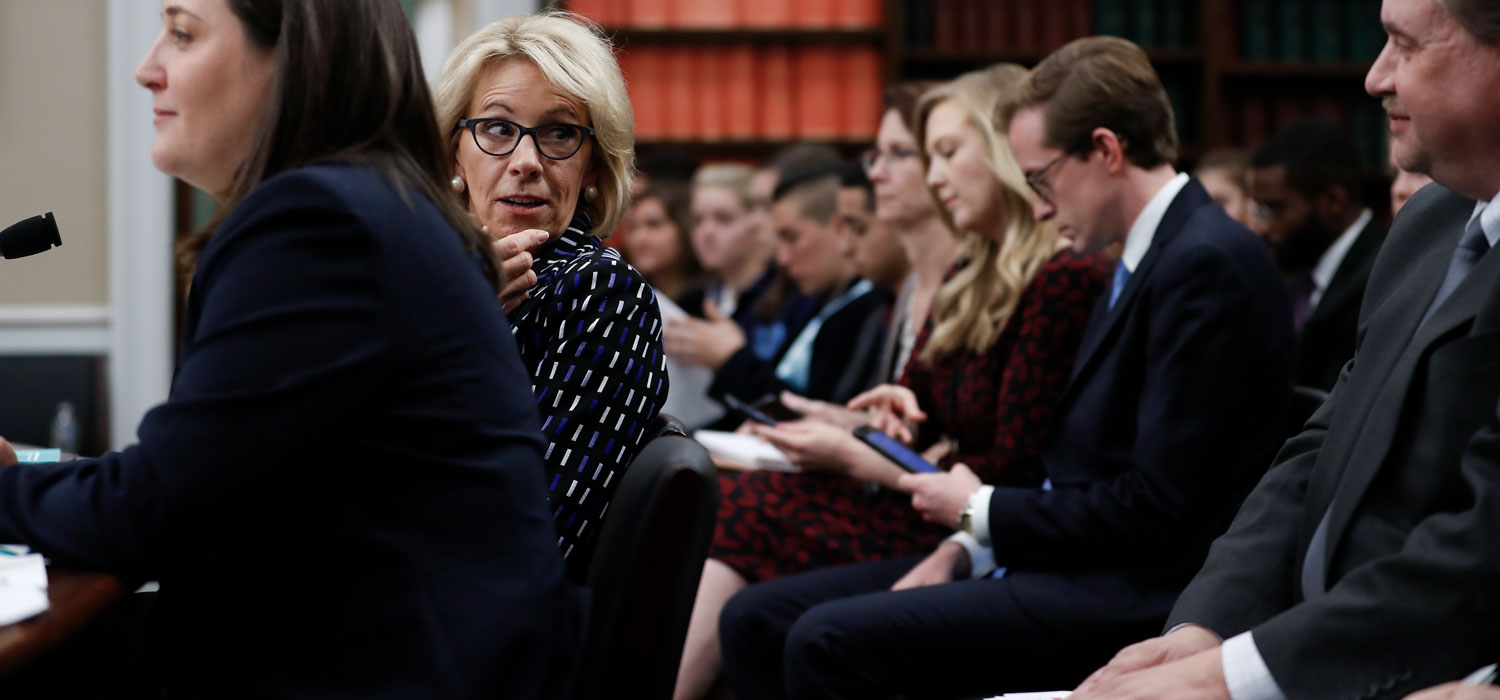
<p>Education Secretary Betsy DeVos, second from left, joined by Education Department Budget Service Director Erica Navarro, left, turns to speaks to people behind her before she testifies on Capitol Hill in Washington, Wednesday, May 24, 2017. Photo by Carolyn Kaster/AP. </p>
Secretary of Education Betsy DeVos and the Trump administration have announced their intention to eliminate the gainful employment (GE) regulations, a move that would strip students and taxpayers of protection from exploitation by postsecondary institutions that do not provide meaningful educational opportunities.
To justify this change, the Department of Education has misrepresented my research, creating a misleading impression of evidence-based policymaking. The Department cites my work as evidence that the GE standard is based on an inappropriate metric, but the paper cited in fact presents evidence that would support making the GE rules stronger.
The GE rules, which cover all programs in the for-profit sector and nondegree programs at public and private nonprofit institutions, restrict the flow of federal dollars to programs with graduates who don’t earn enough relative to their loan payments. The regulations are designed to prevent institutions from taking advantage of students who spend time and energy in programs where they accumulate large amounts of debt that they are unable to ever repay, leaving the taxpayers on the hook for the bill and the students without a decent education.
The current rule requires that the median debt level for a program’s graduates not exceed 20 percent of the discretionary income of the mean or median graduate, whichever is higher. To make the regulations less stringent, the rule’s authors added a second standard, allowing programs to qualify if they meet the first standard or if the average graduate’s debt payment is less than or equal to 8 percent of their total income.
Our examination of a range of evidence about reasonable debt burdens for students would best be interpreted as supporting a stricter standard.
In its move to dismantle the regulation, the administration cites a paper on manageable student debt levels I co-authored with Saul Schwartz in 2008 that raises questions about the 8 percent threshold. In the notice of proposed rulemaking, the Department of Education claims that “We base our proposal to rescind the GE regulations on a number of findings, including research results that undermine the validity of using the regulations’ debt-to-earnings (D/E) rates measure to determine continuing eligibility for title IV participation.”
They are correct that we were skeptical of this standard for determining affordable payments for individual borrowers, but incorrect in using that skepticism to defend repealing the rule. In fact, our examination of a range of evidence about reasonable debt burdens for students would best be interpreted as supporting a stricter standard.
In brief, our paper looked at a variety of potential reference points for setting guidelines for how much individual students could reasonably afford to spend repaying their loans. Noting that the common standard from the mortgage industry of 8 percent of income had gained wide acceptance in the student debt community, we argued that a better standard for student loans would be linked to borrower incomes.
We concluded that no borrower could reasonably afford to spend more than 18–20 percent of their income on student loans and proposed 20 percent of discretionary income (income exceeding 150 percent of the poverty level) as a standard on which to base an income-based loan repayment plan. (This became the standard for GE.)
Citing my research and its judgment that 8 percent of income is not the best way to measure the affordability of loan payments as a reason to rescind the rules is illogical. The GE rules are, if anything, too permissive.
Our research set a guideline for a level of debt payments no individual student should exceed. Under GE, half of a program’s graduates could exceed this limit before sanctions would kick in. If this research is going to be brought into the debate, it should be used to support eliminating eligibility for federal student aid for more programs—not eliminating the rules.
The Trump administration expresses concerns about blaming institutions for the outcomes of their students, in light of the reality that students’ characteristics, in addition to their educational attainment levels, contribute to their earnings levels. But these rules are in place not to accommodate institutions, but to diminish the number of students who spend time and money in programs that have almost no chance of helping them meet their goals and to protect taxpayers from being left holding the bag when such students are unable to repay the loans they took to enroll in these programs.
A true evidence-based approach to policymaking would do more than cite a few phrases from a scholarly article. It would carefully review evidence about the causes and costs of students enrolling in institutions and programs that fail large shares of their students. It would design policies that would ameliorate these problems, strengthening existing policies and making them more effective rather than erasing years of hard-won progress.
Let’s build a future where everyone, everywhere has the opportunity and power to thrive
Urban is more determined than ever to partner with changemakers to unlock opportunities that give people across the country a fair shot at reaching their fullest potential. Invest in Urban to power this type of work.